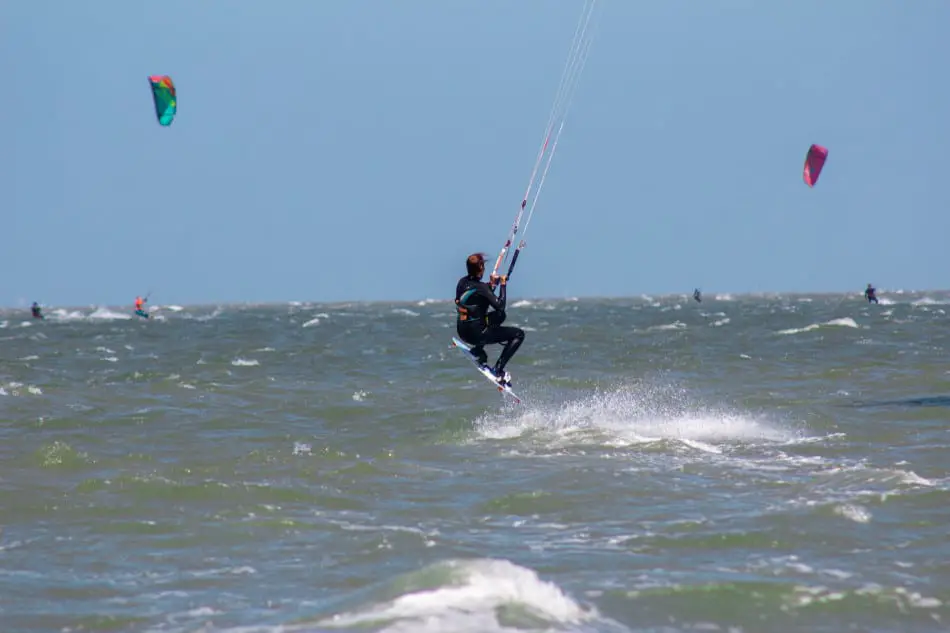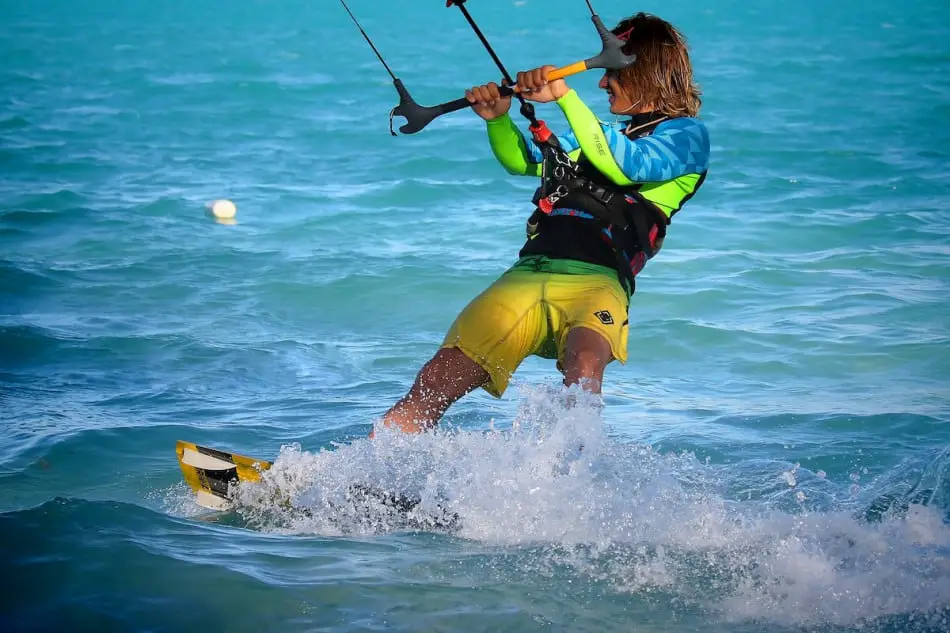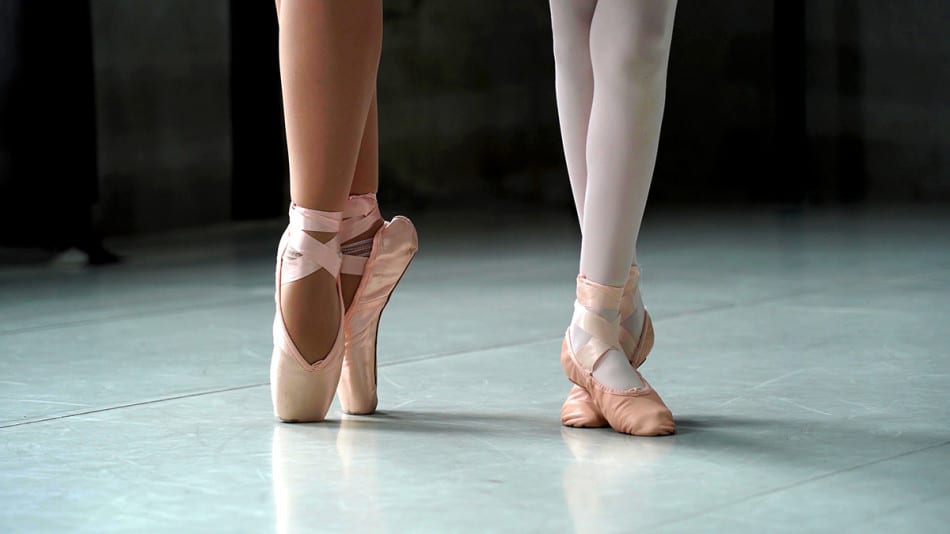Whether on water, land or across snow plains, the kiteboarding’s worldwide appeal grips sports fanatics’ attention.
You’ll need wind and the know-how to control a large power kite, and that’s the start of your dream of freestyling, jumping, riding waves, and even speed racing. But can you learn to kiteboard on your own?
You can learn to kiteboard on your own. Also known as kite surfing, kiteboarding needs a handle-bar grip on a kite, with back and front strings in place, and learning how to tell up- from down-winds. Launching and landing a kite is a skill you can do on your own.
The thrill of being rigged up, your hands on the bar and the strings and kite high, is a moment many a kiteboard enthusiast can’t wait for. The take-off at sea and on land depends on launching a kite into the air.
From there, you have to control it and even learn to land the kite afterward.
If you long to be part of the kiteboarding community, there’s a lot to learn to boost kiteboarding on your own.
You Can Learn To Kiteboard On Your Own
Kiteboarding is fun, that’s for sure. Ask any kiteboarder, they don’t take it too seriously. With a nod of assurance you get, you’ll know that kiteboarding’s less about the board and more about the kite.
The relationship between the kite, the board, and you is crucial. And, as if giving away a life secret, kiteboard enthusiasts say: remember to fly the kite!
Kiteboarding can be done on your own or by watching others, and also from tips, and quick guides, to make practicing easier.
If you are keen, you’ve possibly watched many kiteboarders make mistakes or do pretty well.

As much as you learn by doing and your motor skills and agility affect how well you do it, getting the basics in place first makes kiteboarding easier.
Kiteboarding is no exception – we learn from others and on our own. A lot we learn about kiteboarding comes from conversations, online videos, or directly from imitation.
Learning to kiteboard is a skill that demands that you’re fit and agile. Being tossed by the wind and controlling the kiteboard is part of the sport’s charm.
Flying the kite is the basis for kiteboarding; the board comes later. How the kite is flown depends on the wind; with practice, this becomes second nature.
The kite makes this sport! And, when you’re kiteboarding, you don’t even watch the kite – the kite is somewhere in your peripheral vision.
You can learn to kiteboard on your own by starting slowly. With this in mind, the start is learning how to fly a kite. The number one trick is to get control over the kite – both learned and passed on.
Some basics are:
- Launching a kite
- Landing a kite
And besides launching and landing, you must know the wind’s direction, gauge the wind’s strength, and know if it’s a down- or an up-wind.
You also must be able to control the kite in a wind window – a position in the sky that affects a kite’s pull-action as either strong or weaker.
A kite’s action in a wind window will influence your ride.
-> Read Also What Is An Autodidact?
Learn To Launch A Kite On Your Own
You can learn how to launch a kite on your own. This is arguably the most essential part, and some say it’s like pitching a tent – getting the guide ropes in positions first.
You can start by looking at videos or YouTube tutorials on how to do this.
Whether you are using a trainer kite to practice, which is lighter in weight and easier to maneuver, or a full-scale, heavier and cumbersome one, the principles are the same. The basics of launching a kite can be learned on your own.
You can get the hang of launching a trainer kite and then use the skills to fly a heavier and even stronger kite later. Aspirant kiteboarders know they must start with lighter trainer kites on the beach before hitting the water.
Using heavier kites takes more effort; you could be swept off your feet more quickly. And even decide kiteboarding is not for you.

Take The Kite For A Walk
You can master the first stage of kiteboarding right there on the beach. The best way is to take the kite for a walk – get the kite up in the air and then walk along the beach, moving the kite from left to right with your wrist movements on the bar.
You can see the tension between the kite and in the lines and learn to manipulate the kite. This is also how you learn to gauge the wind.
Of course, the kite is only up in the air after you’ve learned to correctly lay out the lines. Then connect these to the kite and, via the bar, to the harness around your waist.
Running Outer Center And Side Lines
You can teach yourself how to run the side and center lines between the kite and yourself. You will see that the best way is to lay the lines out on the beach or a level stretch of land and then recheck these to make some the lines are straight and not entangled.
Choose a safe spot that’s not crowded with people or near rocks; where you put the lines is where you’ll launch.
Most modern kites have an inflatable ring that forms the top arch of a kite – start with inflating this. Then you can lay out the strings – not yet attached to the kite – and draw these back to the spot where you will stand when you launch the kite.
Once you have these in place, attach the strings to the kite, and step back to the position you’ll be in.
Then attach the strings to the harness and hold the bar. You can learn how to launch a kite on your own. Being taught how to tell the direction of the wind and to know if you should start up- or down-wind is essential, though (see below).
Launch Kite Down- And Up-Wind On Your Own
Launching a kite depends on your position – this can be starting up- or down-wind. Some kite-boarders even start from a position across the wind.
For many, the starting position can be controversial, and beginners are told it’s best to set up a kite down-wind. The position influences the running of the lines.
You can do the lines independently and need to know not to cross these. Also, you need to run the lines correctly with no twist in them and properly attached.

You can learn to attach the lines to the kite and the bars. You can be taught that running the lines with the kite in a down-wind position allows you to do a pre-launch check.
You are then ready to launch the kite and control or manipulate the kite’s movements by moving the bar inwards and outwards. The movements with the bar are best taught but, once shown, are easy to learn on your own.
What you learn from others is that it’s harder to check on your bottom lines when you start up-wind, and it’s almost impossible to check if you set out your lines at a cross-wind angle.
As you start out and learn on your own, the simplest way is to start downwind. And, once a kite is in the air, you can move into position. Being taught the basics is one of the easiest ways to learn independently.
As much as the laying out of the lines from the kite to where you’ll be hooked up is crucial, so it is understanding what a wind window means (see below).
-> Learn More about Self-Learning vs. Classroom Learning: Which Is Better?
Getting To Know The Wind Window
If you’re out there, with your kiteboard kite in the air, and you’re unsure of what to do when it dips and crashes down, you must take note of the wind window.
You can learn on your own, but being told about the aerodynamics of kiteboarding and how this works, is better.
As a beginner, the wind window is the down-wind side – a half-dome shape with a radius from where you stand to where the kite is. The distance is roughly as long as the kite’s lines.
The dome or window has equivalent clock numbers with nine at the left near ground level, then 10 and 11. The center of the wind is at 12, and 1, 2, and 3 (also at ground level) are on the right.
You can work these positions out on your own or, better still, learn from others. These positions are simply the different power zones affecting how a kite flies.
These are technical areas that are best learned about and then put into practice.
You will understand the power zones from working with the kite on land. Also, steering a kite more firmly causes the kite to pull harder to the left or right side.

If you’ve spoken to kiteboarders, you’ll know the kite’s position influences its flight and the strong or weak dives. The dives are the fun of the sport.
From the ground up, as far as being above one’s head, a kite’s position in the sky is calculated as the center of the half-dome shape, a position set as 12 o’clock (see above).
Kiteboarding depends on basic principles like the kite window – positions for where to fly the kite that’ll affect kiteboarding.
Learning about the wind positions while on shore is a good step. And an essential step for getting to sea from the shore.
With your kite high up in the air, you wade with your board across the surf. You need to get to where there are no waves and start to kiteboard.
You also have to know what to do if your kite goes low, crashes, and you have to relaunch. Learning these techniques is better than a trial and error approach.
Learn To Land A Kite On Your Own
Once the kite is in the air and you are walking along the beach, you’ll have to learn how to get it to land. You don’t always have someone to assist and have to do the landing on your own.
Some talk about getting your kite to sit, literally getting the kite to end up on the ground.
If the wind is blowing strongly, you won’t be able to get someone to help. You also have to avoid getting your hands wrapped around the lines. These are skills best taught.
Standing Up On The Water On Your Own
Walking along the beach, even sitting down on the sand, and practicing getting up with a kite are somewhat different when you are beyond the waves and want to kiteboard. As much as you think you know the principles, being out at sea is a different story.
Your agility and eagerness might be core strengths, but there’s more. You need the correct stance – a learned maneuver.
Out at sea, it’s a dance with a kite. You are on the board, depending on what you make of the wind and how you steer the kite. If the kite goes to the right, you must pull the bar to the left and the other way.
You can learn that starting out doesn’t mean you’ll be riding for a long stretch, like riding 100 yards or until you crash!
At first, it’s best to ride for one to two yards and learn to stop. You will learn that you’ll need to build up your power slowly. You also will learn that if you allow too much power, you could fly nose down into the water.
Again, in the deep water, you learn by yourself based on what you have seen, heard, and even been told to expect.
Coming Up And Not Falling Down
What you must have been looking forward to, standing up and gliding across the waters, appears more challenging. You might be a natural kiteboarder, but it helps to know what others do.
Once you have the board on your feet and the kite under control, you can come up into a standing position from leaning back. The position is similar to getting up from sitting down on a chair! But, getting there is best taught.
The next move you can make is standing up and leaning forward. You don’t want to be wholly upright but standing with your legs slightly bent.
Again, though it can be learned on your own, basics like learning with controlled stops make it easier. Controlled stops are shorter glides, riding over shorter distances rather than going flat-out for 50 yards or more.
Kiteboarding is a high-risk activity, and combining the know-how and plenty of practice makes it possible. You can learn to kiteboard on your own, but learning from others and experts makes the process smoother.
You can avoid not knowing how to make a self-rescue attempt from a crash. And if you’re out there at sea, learning to relaunch will be easier if you’ve been taught before.
Practice What You’ve Learnt
You can learn kiteboarding from online tutorials. There is a glut of information on handling a kite, getting up from a sitting position, and manipulating the bar to raise the kite’s height.
You can also learn how to bring a kite down to 45 degrees and do controlled stops with plenty of live videos on YouTube.
The kiteboarding techniques seem simple or relatively straightforward, but these need to be practiced.
The best place to practice is on the beach; getting kiteboarding right there is only a start. On the water, it’s different. Getting training will help you know what to do. Kiteboarding is, to an extent allowing the kite to move you.
But you need to know what to do with the board too. Here again, actions are simple to do once you know.
You need to know from others’ experience that it’s better to move the kite less at first. You want to avoid being lifted up (or lofted) and even pulled (or dragged) by a kite.
There are some guides, which you can find through trial and error, or practice and get right. One is that you want to kiteboard with the kite in positions between 11 and two. The overhead or 12 o’clock position will let you lose your balance and fall down.
With practice, kiteboarding becomes easy; you’ll be able to handle the board in the water, and if you lose it, get it back by controlling the kite.
The same goes for handling the board. Here again, it’s best to know what board to choose – one that goes in both directions is recommended over the surfboard types or one-directional style boards.

Take It Easy To Avoid Mistakes
If you’ve watched kiteboarding, you’ll know the thrill. It looks easy but takes skill. Many experts say they don’t rush to get on the water. Get kiteboarding right on the land. Some say it’s confidence; for others, skill.
Kiteboarding is about you and how you learn best. Getting the correct input at the beginning makes the difference and also is an enjoyable learning experience.
Kiteboard skills are best learned and then put into practice. You can hook up a kite by yourself and get the lines to run downwind, but on the water, it’s the wind, the kite, and you on the board. You don’t also stay on the board.
You can lose it and often have to find a way to get back to your board. A few tips and tricks can help, and you must also learn about safety.
-> Learn more about the 7 best websites for self-learning
Conclusion
Though the basics of kiteboarding can be taught, practice is needed to make it work. Almost anyone can learn to kiteboard.
But you must know how it works – from being able to tell the weather and the wind and even knowing what you do when you crash and injure yourself at sea.
Much is about maneuvering a kite with a board under your feet. There is a lot to learn from others – the mechanics of the back, front and central lines from the kite to where you are.
You must know about a kite’s aerodynamics and how this affects you – on a board, in the water, or on land.
But in the end, taking all into account, you can learn to kiteboard on your own.
References
- https://www.redbull.com/us-en/beginners-guide-to-kitesurfing
- https://www.coachmag.co.uk/adventure-travel/8417/learn-to-kitesurf
- https://www.youtube.com/watch?v=6HELIq9giwc
- https://www.youtube.com/watch?v=oWOP2cMs72I
- https://www.youtube.com/watch?v=mP5XLYSqKQU&t=116s
- https://www.youtube.com/watch?v=hRN2FMwbnro
- https://m.youtube.com/watch?v=3BTgyiNSPmc
- https://m.youtube.com/watch?v=0IvY3Nqxwpg
- https://en.wikipedia.org/wiki/Kiteboarding
- https://www.youtube.com/watch?v=yLS-6DVNt7k
- https://www.youtube.com/watch?v=jAUct7Av7xw
- https://www.youtube.com/watch?v=SGunSQnLc3s
- https://www.youtube.com/watch?v=3EnJ2swzWIw
- https://www.realwatersports.com/blogs/news/when-can-my-kids-learn-to-kite






